The Seekamp name dates back to – at least – November 25, 1481 [1]. That Friday, Heinrich Clüver [2] sold a piece of land near Bollen known as the Sehekampswerder to the church, who in turn leased the land [3] to two brothers: Hinrich and Brüne. They didn’t have a surname yet. But thanks to the lease, they became known as Hinrich Seekamp and Brüne Seekamp.
Werder are small, cultivated pieces of land, on a river, which become rich and fertile over time through the ebb and flow of river floods. If we really delve into the meaning of the name Seekamp, we have to split it into two. See in german means lake. Kamp is a Low German (Plattdütsch) word meaning ‘enclosed, fenced, or hedged piece of land’, which in turn comes from the Latin word campus meaning ‘plain’.
So a Seekamp, in the literal meaning of the word, is a lake-field. The land in question here is also known as Clüverswerder, on the banks of the river Weser – the lake, or See, is clearly shown.
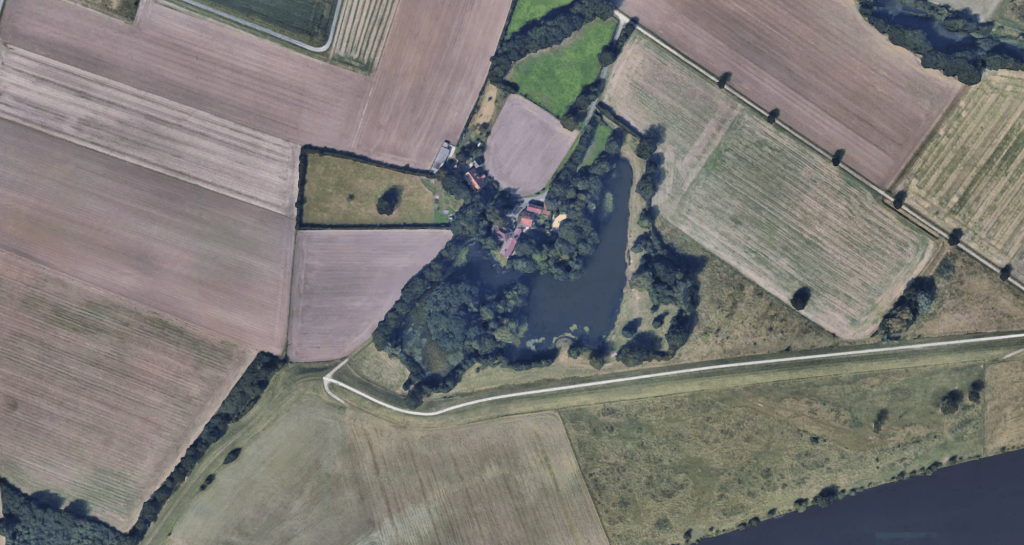
Clüverswerder today isn’t much bigger than it was in 1481 when Hinrich and Brüne Seekamp first farmed the land. The surrounding villages, like Achim, Bollen, Uphusen, and Bierden, are in essence unchanged in character since the day that Bruno Zee left. This is a region that prizes history, heritage, and storytelling, and it seems likely there are more stones to be upturned in researching the history of the Seekamps here.
1646 – Sähekamps Wehrder and border disputes
A document from 1646 presents some more information on the Seekamp family, and the origin of the name. The original German version is below in the footnotes.
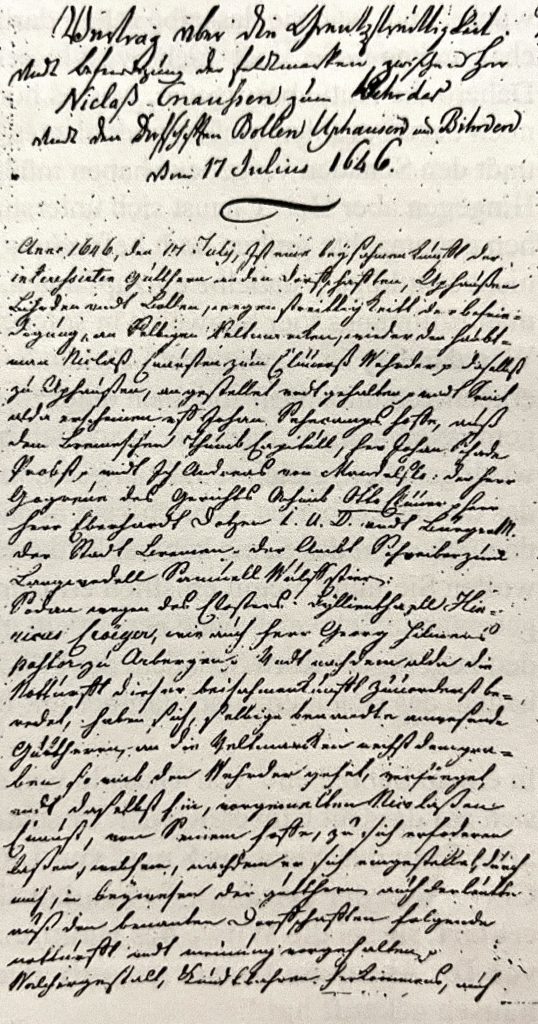
via Ulrich Budler, “Das adliche Gut Clüverswerder”,
“In the year 1646, on the 17th of July, a gathering of the interested landlords of the villages Uphausen, Bierden, and Bollen was held regarding a dispute over the fencing at the same village boundaries, against Hauptman Niclaß Cnaust at Clüver’s Wehrder in Uphausen. The meeting was organized and held, and there appeared at Johann Sehecamps’s farm, from the Bremen Cathedral Chapter, Lord Johann Schade, Provost, and I, Andreas von Mandelslo: the Lord Gogreve of the Achim Court, Otto Clüver, Lord Eberhard Dotzen, J.U.D. and Citizen M. of the city of Bremen, the office scribe of Langwedel, Samuell Wulfstiner. Then, on behalf of the Lyllienthael Monastery, Hinricus Croiger, as well as Lord Georg Hilmers, Pastor at Arbergen. And after there, the necessity of this gathering was firstly discussed, those named present landlords went to the field boundaries next to the ditch that goes around the Wehrder, and from there, called to Nicolaißen Cnaust from his farm, who, after he presented himself, was held accountable by me, in the presence of the landlords and the people from the neighboring villages, for the following necessity and intention. In the manner that, of known custom and from time immemorial, it has been observed and practiced that the former owners of the same farm and estate at Clüver’s, or as it has been known from old times, Sehecamps’s Wehrder, were obliged, still are, to maintain a ditch and fencing around the same Wehrder at their own sole expense, so that no damage to corn or otherwise would be inflicted upon the neighboring and surrounding field boundaries by his livestock, or if such should happen, the people had the power to impound (seize) his livestock and drive it in until it was released again and the damage compensated. On the other hand, if such fencing is not made everywhere and the neighboring livestock overreaches, the owner of such Wehrder then has no right or power to impound or seize it.
As all this then, with Johan Daelweg, who has served for so many years and from youth at the Clüver’s and Monnichhausen (Münchhausen) on the same Wehrder and looked after it, otherwise himself for himself administered the same Wehrder and the associated lands for about 9 years, also to other old people and protocols to show and prove, and now again by the same Johann Dallwegh, enclosed in detail, that specifically the Struckhausers living in Bollen, are obliged to make the fencing from the Weser up to the pond, the remaining fencing, however, from there up to the Döhlenwurth, from there around the bush, behind the Baumhofe, up to the small Schlabhaum and around the Kuhlen and further at the Lake and Wölktken Sehecamps’s land up to the Weser, outside the dyke, is solely the responsibility of the owner of the same Wehrder. Now, however, the named neighboring villages have often complained and lamented against their landlord to the utmost, that such fencing was in no way made by him, Cnaust, but lay open everywhere, as the landlords also now found themselves in plain sight, and great damage was thereby inflicted on the people’s corn as seen, and when it was impounded over it, he let it stand for several weeks and did not want to release it.
Therefore, the people feared that if he might spoil it, they would still have to pay for it, and often let it run again without compensation and had to suffer the damage in vain. On the other hand, however, Mr. Cnaust took it upon himself when the livestock of the villages, due to his unmade ditch and fencing, strayed into it, even though they were not obliged to guard it, to impound it until it was released. Similarly, Herrman Bollmann’s four pigs were still in such impoundment with him. Therefore, if in such a state of affairs, the landlords recognized this as unfair and also from the credible report drawn in and from the current inspection, found so much that he, Nicolaus Cnaust, was held liable, like his predecessors, to maintain the named fencing in such a way that no damage would come to the neighbors from it, and also not to impound the neighbors’ livestock because of it. So they have earnestly admonished him to first release the impounded pigs to Bollman without charge as compensation, also to reimburse the people for the inflicted corn damage according to fairness and then to maintain neighborly relations so that no one has cause to complain justly.”
In the context of the Thirty Years War, the fact that such a meeting could take place provides an indication that the impact was not as severe as in other parts of Germany. From the Peace of Westphalia in 1648, the Bremen area came under Swedish rule.
Clüverswerder & the Sehekamp
The history of the Seekamp family is inextricably linked with the history of the Clüver family. The document above from 1646 notes that “In the manner that, of known custom and from time immemorial, it has been observed and practiced that the former owners of the same farm and estate at Clüver’s, or as it has been known from old times, Sehecamps’s Wehrder, were obliged, still are, to maintain a ditch and fencing around the same Wehrder at their own sole expense“
The first known Seekamps – the brothers Hinrich Seekamp and Brüne Seekamp – farmed the land at Clüverswerder in 1481, owned by the Clüver family. Indeed the Clüverswerder and the Sehecamps’s Wehrder are one and the same name, and the Sehekamp name pre-dates the Clüver name. There is even the possibility that the Seekamp family name pre-dates the Clüver family name in the area.
The Clüverii Chronica, published in 1958, may have more insight.
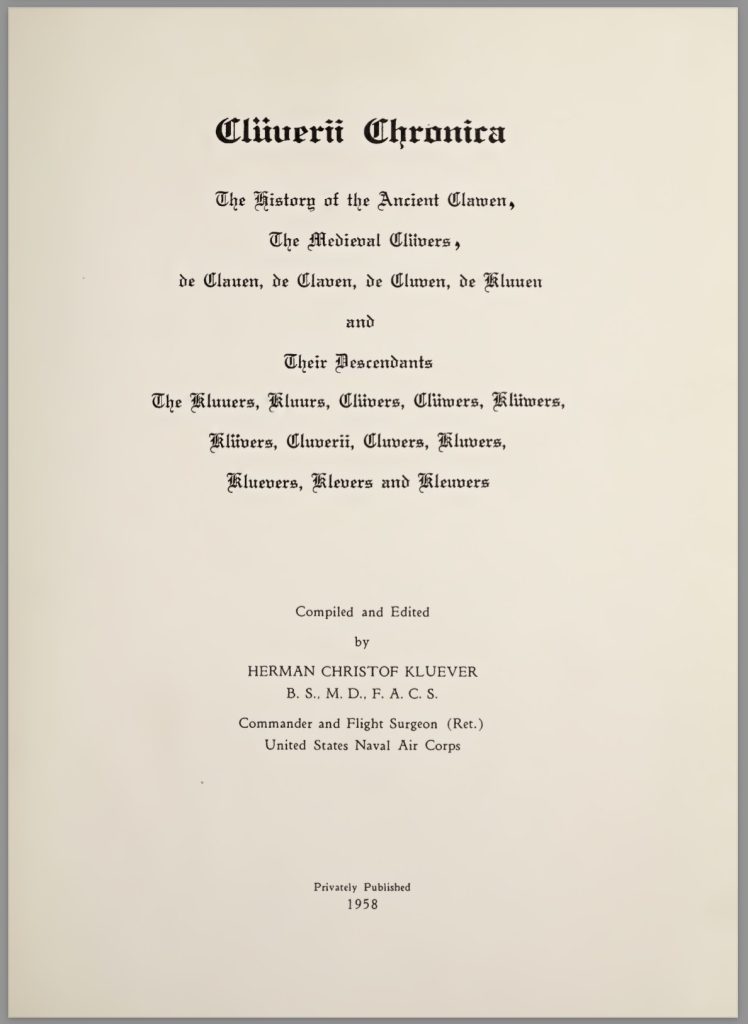
An even earlier book, from 1663, “Clüver, Philipp: Philippi Cluverii Germania antiqua cum Vindelicia et Norico” – available here – may also hold information. Sharpen up your Latin skills.
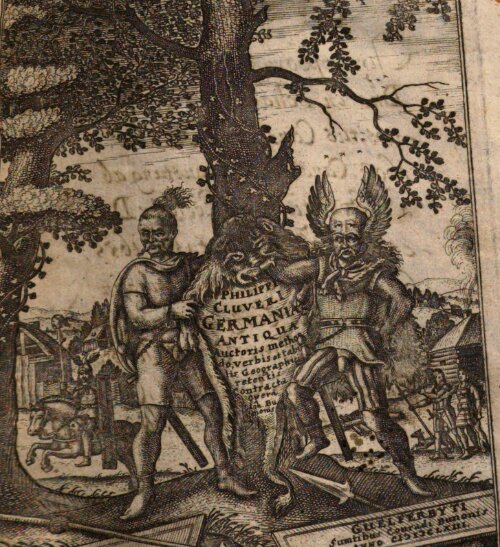
The Clüver connection
An excerpt from the Clüverii Chronica provides historical context to the homelands of the Clüver family, and by extension, the Seekamp family:
“The Thirty Year War (1618-1648) was a particularly hideous religious war. Yet, early Swedish participation was far different from what it became in later years. Gustavus II Adolphus (1594-1632) was a fine Christian man, and the discipline which he demanded maintained the conduct of his soldiers on the highest level. During the Battle of Lutzen, on November 6, 1632, the king was killed while his forces were disorganized because of a very dense fog; disorganization presented the possible danger of defeat. But when the White Charger, the king’s own horse, with an empty saddle, came thundering back among the disorganized Swedes, their character chrystalized into an avenging fierce hate. They regrouped and drove the Catholic forces from the field of battle. Death had removed the restraining hand of a good king and further Swedish participation in this horrible war was changed methods of other participants in by adoption of attitudes and the struggle.
The death of Gustavus brought France into the active fighting. For the next fourteen years Germany became the battle ground for French, Spanish, Swedish and Austrian armies. These troops learned the impunity and advantages of plunder from the outlaw army under Manifield and the degenerate armies of Tilly and Wallenstein. They reduced the country to a state of misery that no historial has been able to describe save by detailing the horrors of one or another village among the thousand that were ruined. The population was reduced by the war from 20,000,000 to 6,000,000 and as a net result Germany remained for 150 years more, in the stillness of exhaustion. It is true that peace was signed in 1648, but the fighting and the occupations continued. The Great Northern War (1700-1721) ended the Swedish occupation of the homeland of the Cluvers by substituting the Danish for the Swedish occupation (63, 64). The alliance against Charles XII of Sweden included Russia, Prussia, Saxony, Denmark, England and Hanover. The Danes conquered the former Archbishopric of Bremen and Bishopric of Verden and took possession but at the close of the war, by virtue of the peace of Stockholm (1719) the homeland of the Cluvers became a part of Hanover and thereby came under the authority of King George I of England, who was also the Elector and Prince of Hanover.
Thus of all the wars that have raged across the homeland of the Cluvers, the Thirty Year War was undoubtedly the worst. With its religious hatreds and faith, with its mass of intrigue, hardships and strength, with its horror, despair and courage, it is overwhelming for the human mind to grasp in its entirety. Otto Clüver, Count of Cluvenhagen, was the last magistrate of the District Tribunal of Achim. He had two daughters and no sons. After he had been removed as magistrate by the Swedes,a feudal court was held in the district in 1684.
In 1627 Tilly, the commander-in-chief of the Catholic League, sacked and burned the out buildings around Cluversborstel–the bastion itself was left standing. During this period the suffering of the people living in the region under the jurisdiction of the old District Tribunal of Achim was most unbearable. There appeared to be no end to the atrocitious deeds of Tilly’s troops. In desperation, Count Alverich of Cluvenhagen addressed a letter to the imperial general, pleading for mercy for his people. The general was stationed at Rotenburg; he had his headquarters in one of only two houses which he had permitted to remain standing in order to suit his purpose. All of the rest of the town of Rotenburg he had burned to the ground. In reply to Alverich Cluver’s letter, Tilly sent out his so-called “Directive for protection of the people of the District of Achim (Schutzbriefe)”. This directive did not change the horrible conditions in the district and the suffering of the people continued without interruption.
Otto Cluver, Lord of Lessel and Baden and.last of the Cluvers of Cluvenhagen, was functioning as Count in 164b, under the good graces of Archbishop Friedrich, son of Christian IV of Denmark. In fact, Otto actually held his title and office of Count of the District Tribunal of Achim as a grant (infief) from the Archbishop. This association with the future king of Denmark proved to be unfortunate. In that same year the Swedes not only attacked Christian IV of Denmark but Swedish troops under Count Konigsmark also overran and occupied the Archbishopric of Bremen, according to Maj. von Hassel “murdering, raping and burning” out the countryside; the Castle of Cluversborstel they left in ruins. Everything that in any way reminded the Swedes of the former bishoprics was totally destroyed or abolished and the Dukedoms of Bremen and Verden were established to replace them. During this period conditions throughout Germany were appalling, yet in the homeland of the Cluvers conditions were even worse.
The Swedish general, Count Konigsmark, became Count of the District Tribunal of Achim on May1, 1649, through appointment by Queen Christian of Sweden. The queen also granted the descendants of Konigsmark the right to inherit the office and title. Otto Cluver appealed to the courts but he died before
a decision could be reached. Segebade Cluver continued the litigation. An unfavorable decision was reached April19, 1675, but Segebade was already deceased. How these Cluvers died has not been recorded.
In 1675 the “undisciplined hordes of the Archbishop von Halen” broke into the Dukedom of Bremen to wreck vengeance upon King Karl XI of Sweden (1675-1680). Before the inhabitants had time to recover from the terrors of this war they were subjected to the further suffering brought by the Great Northern War (1699-1721). The homeland of the Cluvers became part of Hanover when the latter war ended. The ruins of Cluversborstel and Cluvenhagen, at the death of Metta Maria Cluver, Sister Superior of the Convent of Neuenwalde and last legal heir of Cluversborstel, passed on June 17, 1759, to Major a.D. Lorenz Ernest von Hassel, a distant relative of ‘the Cluvers.
Earlier history of the Clüver Clan
From Clüverii Chronica p 261-262, orig text in German by W. von Hassel, 1896.
“During several centuries of strife between the Archbishops of Bremen and the Dukes of Bilung and Welf of Saxony for the possession of the District Court of Wimodi (Gaugrafschaft Wimodi), the obstinate Cluvers developed into an independent and powerful clan with extensive holding throughout the low¬ lands of the Wumrne. The District Court of Wimodi became extinct during the 11th Century but the Cluvers continued to hold undisputed authority in the wide territory between the place where the Veerse enters the Wumrne as far to the west as Ottersberg and from the convent at Zeven in the north to Achim in the south. They owned numerous farms throughout this region and collected rents and tribute from these holdings. The names Cluvenhagen, Cluverswerder and others even today still refer to these former owners. They exercised their own jurisdiction over their extensive possessions and like the von Stote nobility (Edlen Herren von Stote) they recognized no other authority except the emperor.
It is well known that the Cluvers in 1090 gave Bishop Rudolf I. of Verden a tract of land for the purpose of building a strong castle where the united rivers of Rodau and Wiedau meet with the Wumrne. It was a piece of waste land full of deep marshes and was therefore practically worthless, yet to compensate the Cluvers, most likely for the loss of fishing rights, the bishop was bound to deliver to the former owners 360 eels annually. The boggy subsoil created great difficulties when the castle was built, but it also made the castle almost impregnable. The red brick that were used in building the fortress were taken from the ruins of Bardowiek Castle. The new fortress was named Rotenburg because of the color of the brick from which it was built.
After the fall of Henry, the Lion (1180), the warlike minded Archbishops of Bremen sought to extend their territory on all sides and to fortify it. The bishops had already been granted control over the District Court of Lesmona (Lesurn) by Emperor Henry IV, after the death of the pious Countess Emma (1062). To strengthen their position they erected strong castles at Beder- kesa, Monsove (l) near Beverstedt, Hagen, Ottersberg and Otterstedt. The castle wardens whom they placed in charge of these fortresses assumed the title of counts (Grafen). It is well known that the free inhabitants of Steding were subjugated with the help of an army of crusaders. Even the von Stote nobility who called themselves counts were forced to acknowledge the archbishop as their feudal lord after the battle of Altenesch (June 1234), in which the von Stotes fought on the side of the Archbishop. The Cluvers soon followed their example.
There are no other records of the Cluver clan for the next one hundred years. In the latter half of the 14th Century Gise and Alverich, the two sons of Johann Cluver, divided extensive holdings of their father between themselves. The later Cluvers of Cluversborstel descended from the older Gise lineage; the younger Alverich lineage received the possessions in the District of Achim and in Verden. The latter seems to have split into var¬ ious branches. At any rate there were during the middle of the 16th Century owners by succession of this family in Baden, Embsen, Cluverswerder and Sagehorn. Ruins of their former castles may still be found in this region. The main ancestral seat of the family, however, was Cluvenhagen. Various members of this family were residents of Bremen, and their names are well represented among the members of the cathedral chapter. They are also mentioned as castle wardens of the fortress of Ottersberg (and were the Magistrates of the District of Achim). They continued to hold the latter office for an unbroken period of years until Otto Cluver of Cluvenhagen, the last of the Cluvers, was deposed by the Swedish general Count Konigsmark in 1646. He tried to regain his position through court proceedings, but death claimed him in 1660 before the Tribunal of Wismar could render a verdict. His possessions which had shrunk decidedly during the Thirty Year War were divided among his distant relatives. A certain Segebade Cluver of Wellen claimed the succession to the office of Gografe, but it seems that he was unable to prove his descent from the Cluver nobility of the ancient District of Achim. On electionday in 1684 no Cluver appeared. Probably descendants of Cluvers are those whose names are numerous among the farmers and civilians in the districts of Bremen and Verden.”
The Castle at Clüversborstel
From “Clüverii Chronica”, Herman C. Kluver, p 263-267, orig text in German by W. von Hassel, 1896.
In the last years of the reign of Johann III, who had become rather childish in his old age, the arrogant vassals seemed to have asserted themselves again. At first Berthold von Landesbergen, Johann’s capable successor, deemed it advisable to remain friendly with the powerful Cluvers. He confirmed their release from tithing and granted them other valuable prerogatives. From the time of Charlemagne, the small Wieste River which enters the Wumme near Ottersberg had been established as the boundary between the two bishoprics in their documents of diplomacy. On the left bank of the river, the Verden side, the Cluvers had “a place (‘an einem lustigen Ort’) where one could enjoy himself.” An ancient record describes it as a farmhouse with outbuildings built on a man made mound (Wurt) in the midst of bottomless marshes. At this place the bishop permitted Hinrich Cluver to build a fortress for the protection of the bishop’s borderlands. Construction was begun in the year 1478. Around the old mound, Hinrich Cluver had his men dig a double moat which surrounded an outer wall on which his archers could ply their trade. A dam with a flood gate was erected about a hundred feet below the mound. Two drawbridges, the one over the Wieste, the other over the canals, were the only entrances to Cluversborstel or Cluvers castle place (Burgstelle). In those days such a castle was considered impregnable.
It seems that Bishop Berthold soon regretted his willingness to favor the Cluvers. He had entered the bishopric with 300 horsemen to take up his residence at Rotenburg and he had later taken into his service many mercenaries. He also managed to obtain heavy guns. He was greatly disappointed when he discovered that on the very borders of his residence a stronghold had been erected that threatened his territory from the region of Bremen. He was determined to destroy it as soon as it might be feasible to do so. A pretext was soon found. In 1489 when the steward of the Cluvers appeared and demanded the annual tribute of mutton and eels, Bertholdfs stewards not only refused to pay the tribute but they had the representative of the Cluvers killed. This dastardly deed and insult to the Cluvers was soon to be repaid. They entered the bishop’s territory, plundered and burned a few farm houses and imprisoned the bishop’s tenants. The bishop gathered his forces and began a regular siege of Cluversborstel during Lent of 1489. He had with him several pieces of heavy artillery with which he bombarded the castle, but little damage was done. He could not advance close enough to the fortress because of the swampy terrain. A few of the stone cannon balls which were used in those days have been found near the river bank in the morass and are in my possession. The garrison more than held its own. The Cluvers had provided plenty of weapons. Ottrabe von Landesberg, a nephew of the bishop, in drunken arrogance, ventured too close to the castle, and was shot and killed by one of the archers who had climbed upon a chimney of the castle. To starve out the garrison also seemed hopeless because, according to old sayings, the bishop’s men heard the squeals of a pig every morning, such as pigs emit in the last moments of life. However, each morning it was the squeal from the same old sow whose ears and tail were twisted to make her emit those ear piercing squeals, thereby convincing the bishop’s men that the garrison had an inexhaustible supply of fattened animals in their possession. The bishop lifted the siege and returned home. However the warring parties seemed to have come to an understanding; a compromise was drawn up, captured peasants were released, mutton tribute was abolished, and the Cluvers remained in undisturbed possession of their castle. According to later records the tribute of eels was delivered until 1610. During the rule of Bishop Berthold, a delivery of salt from the bishop’s salt mine in Luneburg had finally, after 30 years, been released by the Cluvers upon receipt of payment by parties concerned.
The splendor of the Cluver family rapidly diminished during the Thirty Year War. In 1627 Tilly burnt all the outbuildings of the first island and other buildings were badly damaged. Two families lived in the massive castle, but they were constantly bickering and quarreling among themselves. The castle seems to have been in fairly good condition in 1640. I have reached this conclusion from an ancient description of the castle given to me by the generous Senator Smidt of Bremen. Nothing much is said about the outer appearance of the structure; pictures or paintings of it do not exist. It is stated that many cannon balls were imbedded in the gables; a grim reminder of the siege and of the valorious defense of the garrison.
This information is the last which is available concerning the old castle. Five years later (1645), the Swedish troops under Count Konigsmark invaded the helpless archbishopric pillaging, burning, murdering and raping. The Cluvers could not even have thought of offering resistance, but still the Swedes wrecked the place, as if they wanted to take revenge on the “ancient, noble stone house”. The bridges were burned, making it impossible to get to the ruins except by boat. No funds were available to rebuild the place. Twenty years later only a few walls were left of the once proud castle. The roof had fallen in; the floors had rotted away; the iron had been stolen and no one dared venture inside the ruins without risking his life. The entire building site upon the island with its alders, alder-brake, willows, weeds and brush became a sad sight of neglect and desolation.
One of the two owners remodeled a tenant house into a modest home on the right bank of the Wieste. The other moved to Stuckenborstel and established new living quarters on the highway from Rotenburg to Ottersberg. In 1660 the lineage of Cluvenhagen died out. The two lineages of Stuckenborstel and Clu- versborstel formally divided the entire remaining possessions between them selves. The “corpus bonorum” drawn up for this purpose in 1662 is still in my possession. According to this document the property which was divided was still quite extensive, especially for those times. The land that could be cultivated and seeded by the Cluversborstel branch of the family was valued at 7,000 Reichsthaler; from the grasslands they annually harvested 100 loads of hay. The sheep and cattle pastures (“that none of the tenants dared to use for his stock”) extended a mile around the inner courtyard and timber lands extended as far as to Sottrum. In addition all trees on tenant farms and on common property of the surrounding villages belonged to the estate. About 50 tenant farms are listed in the document; these had to deliver extensive amounts of grain, large numbers of hogs, chickens and other natural products. Interest payments in money were demanded as well as rents, taxes and services by tenants with their horses. The mill was rented to a miller for an annual payment of 10 Malter of rye. A Malter is equal to about 18 bushels. The possessions of the Stuckenborstel branch of the family were just as extensive.The two families had hunting rights for small and large game throughout the districts of Ottersberg (up to the very gates of Rotenburg), Borde, Rahde (as far as Lilienthal Convent), Achim and Tedinghausen. The fish rights in the Wieste, Wumme and old Weser Rivers were valued at 1,500 Reichsthaler annually.
Even though all these possessions were heavily mortgaged, the owners would no doubt eventually have liquidated these debts and have regained at least a part of their former wealth and position if new misfortunes had not come upon them. In 1676 the undisciplined hordes of Archbishop Bernard of Salen invaded the District of Achim and robbed the unfortunate inhabitants of the last of their possessions. These hordes belonged to the army of the Holy Roman Empire sent out to enforce the emperor’s proclamation which in effect outlawed King Karl XI of Sweden. For four years these wild hordes remained in the territory (1676-1680), and during this time the misery and distress of the inhabitants reached almost unprecedented heights. The bishop used to say, “The land is like a cabbage stump which seems to sprout most when it is plucked most.” Now the last supply of grain, the last horse, and the last cow was taken from the farmer. The cost of billeting the soldiers amounted to 50,000 Reichsthaler per month; when these vampires finally left, the land actually choked in its own misery.
The province had hardly begun to breathe again when it was engulfed in the Great Northern War. It has been estimated that this last war cost the double Dukedoms of Bremen and Verden an amount equivalent to 76 tons of gold, or approximately 7,600,000 Reichsthaler. Finally under the benevolent govern¬ment of the Electors of Hanover the dukedoms gradually began to recuperate from the hardships and miseries of the previous century, but the splendor of the Cluvers had departed forever. The Stuckenborstel lineage died out at the end of the 17th Century and the estate was inherited by a Major von Zigeser, who had married a daughter of the last Clüver.
Journeys into the Heath
From “Clüverii Chronica”, Herman C. Kluver, p 273-275, orig text in German by August Freudenthal, 1890
In ancient times Uphusen had a chapel, a subsidiary parochial chapel of Achim, dedicated to St. James; Uphusen at that time belonged to the Achim Parish. This chspel had been built and endowed by members of the Cluver family; consequently, the Cluvers also held the patronage over it. In an old document, dated December 13, 1339, the brothers Nicolaus and Alverich Cluver call themselves deacons of the House of God at Uphusen. According to ancient reports the chapel was supposed to have been built before the church at Arbergen had been erected. The inhabitants of the lowlands (Hollerland) of Bremen are supposed to have come here to worship in Catholic times. There is no longer any trace of the chapel; it formerly stood on the site which is now used as a garden by Architect F. Seekamp. The building was torn down after the Reformation, and the Cluvers of Cluverswerder took back the endowments made by their forebears and gave them to their tenants at Uphusen.
The Cluvers were feudal lords of the archbishop. Various branches of the family resided in and around Bremen and Verden and were very wealthy. For a time they owned the fortresses of Langwedel and Ottersberg. Their family estates were Cluverswerder near Uphusen, Cluvenhagen near Etelsen, Cluversborstel not far from Rotenburg, Vellen near Beverstedt, Baden near Achim, Lessel in the Verden district, Sagehorn and others. They also had a good representation amongst the ruling divines of the Archbishopric of Bremen and the Verden monastery.
The site of the former estate of Cluverswerder is about 2 km. southeast of Uphusen, not far from the Weser. Formerly it was a castle, well protected with moats and ramparts; even today it can be recognized as such. The old fortifications were replaced by a friendly country home with beautiful gardens, parks, canals and man-made islands. Since the Cluvenhagen branch of the family became extinct in 1660, the estate has repeatedly changed.hands. At first it was granted to Captain Kunst von Lilienfeld by the Swedish crown. He in turn bequeathed it to his son-in-law, Captain Schutz von Modersitsky. After the latter died, Claus Mindermann, Recorder and Altermann of Bremen, bought it. Lieutenant General von Klinkowstrom, an old swashbuckler and friend of Pastor Heisius of Arbergen, bought it from Mindermann; the generals widow continued to live there after he died. Her son, G. C. von Klinköwstrom, Castle Captain of Wolfebuttel and later Privy Councillor, sold Cluverswerder around 1772 to a citizen of Bremen and Bleicher Prange. Around 1800 a certain Friedrich Elmken owned it; about the middle of this (19th) century Senator Iken of Bremen became the owner of the place. There is very little left of the former land of this estate; the most of it was disposed of during the 18th Century. The country house and park are now (1890) owned by H. Waite a merchant of Bremen, who has also rented the adjacent hunting rights.
Members of the Cluver clan whose names are mentioned since the beginning of the 13th Century were more closely associated with the Cathedral Chapter and the Council of Bremen than any of the other families of the nobility. Their extensive holdings in and around the city made it necessary for them to maintain this close association both politically and socially. Johann Cluver, who lived in the latter half of the 14th Century, had two sons–Gise and Alverich. These sons became the forefathers of the two Cluver lineages which are named after them. The Cluvers of Wellen near Beverstedt and the Clivers of Cluversborstel descended from Gise. The descendants of Alverich held possessions located chiefly in the Districts of Achim and Verden. The Gografen descended from Alverich. The latter lineage which is also called the Cluvenhagen lineage is considered in the following discussion.
In 1589 Segebado Cluver of Wellen and his brother-in-law, Segebade von der Hude, quarreled over a piece of grassland, and S. Cluver shot his brother-in-law with a blunder-buss and killed him. In the following years, 1593 and 1598, SegebadoTs son, Heinrich Cluver, became guilty of serious excesses in the District of Neunkirchen. He was apprehended and had to serve a prison sentence of several years in Bremen because the District of Neunkirchen was under the jurisdiction of the city. The Council of Bremen was especially disturbed by the friendly, or sometimes unfriendly, intercourse of the Cluvers who were Gografen of Achim and dared to extend the jurisdiction of their office to the very gates of the city.
Albert Seekamp and the Black Monks
In 1546, a council decision is recorded relating to a contract between one Albert Seekamp of Arbergen and the Beguines of the Black Monks. There was a dispute of some kind between the two parties. The original document lies in the archives and needs inspection >. [6]
Tracing the first Seekamps
By the early 1700’s, descendants of Hinrich Seekamp and his brother had become established families in the surrounding villages: Bollen, Uphusen, Bierden, Mahndorf, Embsen, and the towns of Achim and Arbergen. The Seekamp name had become one of the more common family names in the area.
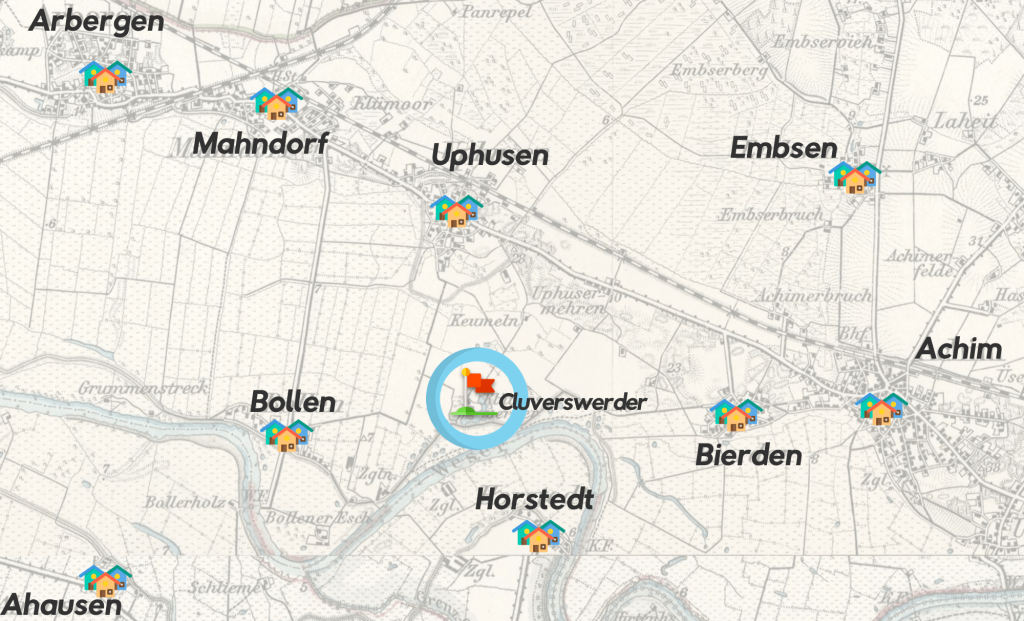
Researching the details of the growth of the family is an interesting challenge. Local genealogists and historians like Heinz Früchtenicht and Ulrich Budler have done incredible work in piecing together church records and legal documents to create databases of births, deaths, and marriages. This makes life much easier for amateur family sleuths like myself! Nonetheless, when we get back to the 1500’s, records are sparse in comparison to the 18th century and onwards.
But what can we piece together about the early Seekamps and their journey out of Clüverswerder? So to the first question: Where did Seekamps first appear in the records of each of these towns?
The source for this research is the OFB or Ortsfamilienbuch – the digital version of the church records for births, deaths, and marriages. For Bollen, the closest village to Clüverswerder, this has been done by Heinz Früchtenicht, and is available through Die Maus, and also Genealogy.net. The latter appears more up to date. While the OFB is predominantly based on Church records, for the timeframe we’re looking at here (1450-1650), most of the records are in fact based on information from Höfakten, or Farm Records – the Church records don’t usually go back that far.
In addition to the OFB material, the “Family Book” of Früchtenicht Biermann, another piece of extensive research by Heinz Früchtenicht, additional information on the early Seekamps is found, and added to the OFB material below.
First records of the Seekamp name in surrounding villages
Clüverswerder
Seekamp family mentioned in the Family Book of Früchtenicht/Biermann, and OFB Uphusen, and OFB Bollen.
1425: Brüne Seekamp. Born est. 1425, Farmer and Leaseholder. “1481 werden die Brüder Hinrich und Brüne Seekamp als Pächter des zur Wasserburg Clüverswerder gehörenden Hofes genannt. Diese gehörte den Herren von Clüver und wurde nach dem Hof gelegentlich auch “Seekampswerder” genannt. Es ist davon auszugehen. daß alle Namensträger Seekamp auf diese Familien zurückzuführen sind“. [>]
1435: Hinrich Seekamp. Birth estimated 1435, Farmer, RC. Mentioned 1481 (as in intro, and above).
1455: Brüning Seekamp. Estimated birth 1455 at Clüverswerder, baptisim in Arbergen or Achim. A Roman Catholic farmer. Mentioned in a document in 1511.
1465: Hinrich Seekamp. Birth estimated 1465 Clüverswerder. Farmer, RC. Mentioned in document from Uphusen 1535 and 1546.
1475: Wilken Seekamp. Birth estimated 1475 Clüverswerder, farmer, RC. Mentioned 1534.
Bollen [>]
Seekamp family mentioned in the OFB Bollen 1400-1650.
1482: Johann Seekamp. Estimated birth 1482 in Bollen, farmer, Roman Catholic. Mentioned in a document in 1535.
1485: Brüning Seecamp. Estimated birth 1485 Bollen, farmer, Roman Catholic. Mentioned in a document in 1535.
1510: Harmen Seekamp. Estimated birth 1510 Bollen, farmer, Roman Catholic. Mentioned in a document in 1563.
1520: Brüne Seekamp. Estimated birth 1520 Bollen, farmer, Roman Catholic. Mentioned in a document in 1576.
1540: Röpke Seekamp. Estimated birth 1540 Bollen, farmer, Roman Catholic. Mentioned in a document in 1576.
1560: Johann Seekamp. Estimated birth 1560, Köther (Small farm holder), Lutheran. Mentioned in a document in 1600.
1560: Hermann Seekamp. Estimated birth 1565, farmer, Lutheran. Mentioned in a document in 1610.
1636: Lefke Seekamp. Born 1636, died in Bollen, buried 28-Jan-1685 in Arbergen. Lutheran. Lefke is the first Seekamp in Bollen with full details. He married twice – first to Hibbel Lerbs in 1676, and again in 1681 to Gebke Meyer. From this marriage, they had one child – Lüer Seekamp, born around 1685, and died in Arbergen in 1722.
1641: Brüne Seekamp. Born 1641 Bollen. Married Beke Struckhusen. Hof No. 5. 4 children [>]
1645: Hermann Seekamp. Born 1645 Bollen. Married Beke Lange, daughter of Johann Lange, Bollen. Hof. No. 7. 8 children [>]
1647: Gesche Seekamp. Born 1647 Bollen. Married Johann Meyer. Hof No. 4 Bollen. [>]
Mahndorf [>]
Seekamp family mentioned in the OFB Mahndorf 1400-1650.
1510: Lefke Seekamp. Birth estimated 1510 Uphusen. Farmer, Roman Catholic. Mentioned 1562. Father possibly Hinrich Seecamp, farmer in Uphusen, Hof Nr. 5. ( vgl. Familiendatenbank Früchtenicht/Biermann ) >
1540: Hinrich Seekamp. Birth estimated 1540 Mahndorf, Farmer, RC, mentioned 1567. Hof No. 5. >
1570: Johann Seekamp. Birth estimated 1570 Mahndorf, Farmer, Lutheran. Mentioned 1595. Hof No.5. >
1600: Albert Seekamp. Birth estimated 1600 Mahndorf. Farmer, Lutheran. Hof No. 5 >. Buried 15-Nov-1675 in Arbergen. Married Wöbbeke N.N before 1631, two children: Johann b. 1631 in Mahndorf, and Eilke b. est. 1642 in Mahndorf.
1640: Göbbeke Seekamp. Birth estimated 1640 Mahndorf. Married Cord Osmers 11-Jul-1670 in Arbergen. Lived in Achim, 3 children. >
Arbergen [>]
Seekamp family mentioned in the OFB Arbergen 1400-1650.
1520: Albert Seekamp. Birth estimated 1520, Farmer, Lutheran. Mentioned in 1549 and 1562.
1545: Hinrich Seekamp. Birth estimated 1545, Farmer, RC. Mentioned 1583.
1627: Johann Seekamp. Birth estimated 1627. Died 24-Jul-1680 in Bremen, buried in Arbergen 28-Jul-1680. Farmer, Lutheran, Hof No. 7. Married Wöbbeke N.N., buried 28-Aug-1685 in Arbergen.
1642: Eilke Seekamp. Birth est. 1642 Mahndorf. Married Johann Reibers. [>] Daughter of Albert Seekamp of Mahndorf.
Hemelingen [>]
Seekamp family mentioned in the OFB Hemelingen 1400-1650.
1490: Brün Seekamp. Birth est. 1490, Farmer, RC.
1520: Brüning Brüning. Birth estimated 1520, Farmer, RC. Hof No.9 Hemelingen. Possibly a Seekamp?
1540: Brün Seekamp. Birth est. 1540, Farmer, RC.
1575: Brün Seekamp. Birth est. 1575 Hemelingen, Farmer, Lutheran.
1575: Hinrich Seekamp. Birth est. 1575, Farmer, Lutheran.
1608: Johann Seekamp. Birth est. 1608. Farmer. Died 1666 in Hemelingen. Hof Nr. 16. “soll aus Mahndorf gekommen sein”. Married Wümmel N.N. 1 son: Marten Seekamp, he maried Wübke Elmers, daughter of Berend Elmers. They had 6 children, all born/died in Hemelingen.
1608: Wöltje Seekamp. Birth est. 1608, Farmer. Hof No. 12. He married Lücke N.N. 2 children, Harmen and Ahlke.
1610: Johann Seekamp. Birth est. 1610. Married Wöbbeke N.N. Hof No. 2. Two children Berend and Albert.
1633: Gretje Seekamp. Birth est. 1633. Died 1693 Hemelingen. Married Burchard Döhle. Hof No. 4.
1635: Lefke Seekamp. Birth est. 1635. Died 1666 in Bremen [>]. Buried Aug 15, 1666 in Arbergen. Two children: Gretje Seekamp (born outside wedlock), baptised 12.04.1665, and Trine Seekamp, born 1667 and married Dierck Reibers. *mentioned under Bremen ref. Die Pest.
1637: Harmen Seekamp. Birth est. 1637. [>]Married Alcke Tietjen 1677. Son of Wöltje Seekamp b. 1608 above. They had one child: Wöltje Seekamp, who married three times: 1. to Ahlke Seekamp, daughter of Albert Seekamp. 2. to Gretje Meyer and 3. to Becke Meyer.
1639: Röbke Seekamp. Birth est. 1639. [>] Married Wöbbeke Meyer 1668, 7 children.
1647: Albert Seekamp. Birth est. 1647. [>] Son of Johann Seekamp (b. 1610 above) and Wöbbeke. Married Anna N.N., 5 children.
Uphusen [>]
Seekamp family mentioned in the OFB Uphusen 1400-1650.
1495: Lefke Seekamp. Birth estimated 1495 Uphusen. Farmer, RC. Mentioned 1549.
1505: Wilken Seekamp. Birth estimated 1505 Uphusen. Famer, RC. Mentioned 1546 and 1557.
1525: Wöltje Seekamp. Birth estimated 1525 Uphusen, Farmer, RC. Mentioned 1567 and 1571.
1535: Wilken Seekamp. Birth estimated 1535 Uphusen. Farmer, RC. Mentioned 1562.
1555: Hinrich Seekamp. Birth estimated 1555 Uphusen. Farmer, RC. Mentioned in a document from 1602 indicating possible wife as Alke N.N, widowed Farm owner.
1565: Johann Seekamp. Birth estimated 1565 Uphusen. Farmer, Lutheran. Mentioned 1602 and 1610. Possible Hof No. 12 “Eichtor”.
1570: Frederick Seekamp. Birth est. 1570 Uphusen. Köther, Lutheran. Mentioned 1602.
1570: Dierk Seekamp. Birth est. 1570 Uphusen. Köther, Lutheran. Mentioned 1610.
1580: Wöltje Seekamp. Birth est. 1580 Uphusen, Köther, Lutheran. Mentioned 1610.
1585: Lefke Seekamp. Birth est. 1585 Uphusen, Farmer, Lutheran. Mentioned 1610 & 1625. Hof No. 10, Uphusen. Married Metje N.N. (she died aged 103 in 1690 in Uphusen).
1595: Johann Seekamp. Birth est. 1595 Uphusen, Farmer, Lutheran. Mentioned 1625 & 1651. Hof No. 12 “Eichtor”. Married Gretje Henken. Five children: Johann Seekamp (est. 1632), Detmer Seekamp (est. 1635, married Metje N.N., 7 children – of which Beke Seekamp moved to Bollen and married Cordt Elmers), Albert Seekamp (est. 1638, married Gesche Struckhusen, 6 children), Hilcke Seekamp (est. 1639), and Gesche Seekamp (est. 1647). Gesche Seekamp moved to Bollen and married Brüne Pape, and died there in 1711.
1600: Brüning Seekamp. Birth est. 1600 Uphusen, Köther, Lutheran. Possibly Hof No. 27. Mentioned 1647 & 1651.
1615: Hinrich Seekamp. Birth est. 1615 Uphusen, died 1685 Uphusen, buried 23-Sep-1685 Arbergen. Farmer, Lutheran. Hof No. 10. Married Gretke N.N., four children: Hibbel, Mette, Johann, Dierk. Dierk died aged 19, no children, but Johann Seekamp, b. 1657. had 13 children [>]. Of these, Gesche and Beke went to Bollen, and Beke married Bösche Seecamp on 26-Nov-1738.
1632: Johann Seekamp. Birth est. 1632 Uphusen. Son of Johann Seekamp (b. 1595 above) and Gretje Henken. Died 1676 aged 44. Hof No. 12 “Eichtor” [>]. Married Gesche N.N. 1 son Johann Seekamp b. 1670 Uphusen, married Gretke Claus.
1634: Johann Seekamp. Birth est. 1634 Uphusen. Died 1686 Uphusen. Married Gesche N.N., 7 children. She died March 1677, Johann then remarried to Lücke Rowohlt in Aug 1677, 6 further children. [>] No mention of parents in OFB.
1635: Detmer Seekamp. Birth est. 1635 Uphusen. Son of Johann Seekamp (b. 1595 above) and Gretje Henken. Married Metje N.N., 7 children.
1636: Harmen Seekamp. Birth est. 1636 Uphusen. [>] Married Gesche N.N. 1677 – this Gesche was earlier married to Johann Seekamp b. 1632 above.
1638: Albert Seekamp. Birth est. 1638 Uphusen. Married Gesche Struckhusen, 6 children.
1639: Hilke Seekamp. 1639 Uphusen, daughter of Johann Seekamp (b. 1595 above) and Gretje Henken. Married Urban Urban.
1646: Hibbel Seekamp. 1646 Uphusen. Daughter of Hinrich Seekamp and Gretke N.N. Married Seba Reiners.
1647: Gesche Seekamp. Above.
1650: Mette Seekamp. 1650 Uphusen. Sister of Hibbel Seekamp b. 1646.
From this list, it’s already clear that the largest Seekamp family center by 1600 was Uphusen. But what about Bremen? Were there any Seekamp’s there by 1600?
Bremen
The OFB for Bremen-Vegesack does’t go back far enough to tell us anything about the period before 1700. There are other sources, however. Below are entries from Die Maus, Bremer Einwohner vor 1650 [>].
1546: Albert Seekamp. “Landmann, wurde am 21. Juni 1546 von den Beginen bei den schwarzen Mönchen mit ihrer halben Wurth zu Arbergen bemeiert” [Urkunden des Bremer Staatsarchivs von 1434 an >].
1581: Frerik Seekamp (Frerik Sehekamp ?) Am 27. März 1581 leiht er vom St. Anscharii-Kapitel 50 Rtl. Source: Schmidtmeyer, Alfred, Urkunden des Bremer Staatsarchivs von 1434 an, 2 Bde. – Das Buch der Akzise enthält auf Seite 3 seine Gebühren-Entrichtung für einen Posten Mehl. Source: Kaufmannsakzisebücher, insges. 99 Bde. im Bestand des StAB, von denen einige von A. Schmidtmayer mit Register als Beilage versehen wurden. 1570, 125. – Er mit seiner Ehefrau Reime erhielt am Freitag nach Heil. 3 Könige im Jahr 1588 das Bürgerrecht, die Bürgschaft für beide übernahmen Claus Wurtman und Herman Rose. ad P.8.A.19.a.3.
15–? Hermann Seekamp. Namhaft im Akzisebuch mit Ankauf eines Postens Mehl, als er dafür die zugehörige Gebühr nach Seite 18 steuerte. SA 1570, 126.
16–? Bruning Seekamp “Von Uphusen aus dem Gericht Achim bürtig, ließ sich am 7. Februar als Neubürger hier einschreiben, und mit einer Musquette und Seitgewehr ausstatten; die Bürgschaft hatten Marten Stöver und Hermann Rowohlt übernommen. Source: Bürgerbücher der Altstadt, Ref. P.8.A.19.a.3.
1603: Hermann Seekamp. “Im Jahr 1603 wurde ein erheblich jüngerer Träger seines Namens als Bürger aufge-nommen, siehe die Kladde Seite 143″ [>]
1609: Johan Seekamp (Johan Sehekamp?) Nach dem Ankauf eines Postens “Vale” also von Pfählen, wurde er urkundlich in der Aufzeichnung des Accise-Einnahmen-Registers für erste Hälfte des Wirtschaftsjahres 1609 im Band I auf Seite 47, und er versteuerte am 22. Mai. – erst im Jahr 1713 ist ein Bürger unter diesem Namen aufgenommen lt. Namenregister. – Unter “Sehekamp” ist er am Freitag nach 3 Könige 1579 eingebürgert, die Bürgen waren Claus Wurtman und Claus Albers. ad P.8.A.19.a.3.- [>]
1610: Hinrich Seekamp. “Landmann in Habenhausen, um 1610 Baumannoder Kötner auf einem dortigen Meierhof. Mahnken, Arster Heimatbuch, 1936 80 ff.” [>]
1616: Herman Seekamp. “Eine weitere Einbürgerung eines Gleichnamigen findet sich im Jahr 1616, siehe Kladde Seite 287.” [>]
1621: Hinrich Seekamp. “Bezieher einer Partie Hopfen, erlegte dafür die fällige Abgabe im Akzisebuch Seite 121. SA 1570, 126. Seine Ehefrau war Anna Voß, ihre Tochter heiratete im Jahr 1621 den Prediger an St. Stephani und Professor der Theologie Hermann Hildebrant. Goldenes Buch Seite 130. In dem Accise-Einnahmenregister des erste Halbjahres 1586 ist er Seite 86 vermerkt. Der im Jahre 1621 vorstehend als Vater erwähnte ist vermutlich mit dem im Jahre 1605 Eingebürgerten identisch, siehe Kladde Seite 149. [>]
1628: Bruning Seekamp. Wurde vom Contributionsverzeichnis für das Neue Werk bereits 1628 als Bewohner des Kirchspiels St. Stephani auf Seite 161 angegeben. Source: Bürgerbücher der Altstadt, Ref. P.8.A.19.a.3, Seite 161
1636: Albert Seekamp. Bürgerrecht. “Ein erheblich jüngerer seines Namens hat im Jahr 1636 das Bürgerrecht empfangen, siehe Kladde Seite 52.” [>]
At this point, there isn’t any strong evidence of a single member of the Seekamp family living in Bremen prior to 1600. Although Albert Seekamp is mentioned above in 1546, the location is Uphusen, not Bremen. Frerik Seekamp was more likely Frerik Sehekamp, and appears unrelated. So, the earliest mention of a probable member of the Seekamp family is 1603, when Hermann Seekamp received the Bürgerrecht, or citizenship of Bremen.
What about Seekamps in Bremen in the period 1600-1700? Die Maus has other information sources for Bremen that paint a picture of the number of Seekamps in Bremen in the 1600’s – and there aren’t many. In the taxpayer registers of the Altstadt of Bremen, the following Seekamps are listed are for the period 1638-1668:
Brüning Seekamp, living in the Stephani district, 1649, 1653.
Brüning Seekamp, living in the Ansgari district, 1653, 1656, 1668.
Carsten Seekamp, living in the Stephani district, 1644, 1646, 1649, 1653.
Leffke Seekamp, living in the Stephani district, 1644, 1649, 1653, 1656.
Tonnies Seekamp, in the Unser Lieben Frauen district, 1642-1668.
In a consolidation of church marriage registers of Bremen, only four Seekamps are listed for the period 1658-1699:
Brüning Seekamp, married at St. Stephani in 1678
Brüning Seekamp, married at St. Stephani in 1678
Brüning Seekamp, married at Unser Lieben Frauen in 1696
Cathrine Seekamp, married at St. Pauli in 1673
Another Bremen source: Baptisms in the St. Petri Dom cathedral, which lists the baptisee and also details about the parents. In this source, the following Seekamps are mentioned.
Anna Seekamp. Born est. 1674, father Brüning Seekamp. Married Hinrich Hesterman 1706 St.Ansgarii.
Gretye Seekamp. Born est. 1672. Married Tonius Lange est. 1694.
Greie Seekampt (sic). Born est. 1689. Married Johann Meyer. >
In the book “Die Pest in Bremen” by Klaus Schwarz [>], Lefke Seekamp is mentioned as dying from the plague [>] and buried on August 15, 1666. Lefke was buried in Arbergen. The church record mentions that the plague at that time was active in Bremen, and may suggest that Lefke also lived in Bremen – perhaps the same Leffke Seekamp in the tax records above. In the same book, Brünings Seekamp is mentioned in 1713, as his wife died from the plague. This Brünings Seekamp lived in the Paulsberge area of Bremen, and was left a widower with two (apparently young) children when his spouse passed away on September 27, 1713. She was buried in the St. Remberti Kirche. The house was cleaned on September 29th, and released as clear a month later. The case of plague was significant at the time, because it was the first indication that it had spread from the Altstadt to the Vorstadt. Finding the entry in the St. Remeberti burials book would perhaps give more information.
Conclusion, so far: Bremen’s records for the 17th century are extensive, with some of the record lists reaching into the tens of thousands. It is therefore apparent that the number of Seekamp’s living in the city of Bremen before 1700 is extremely small. Of those that are listed (above), a couple (Albert, Bruning) are mentioned as coming from Uphusen and Arbergen. It thus appears very likely that the Seekamp’s living in Bremen are connected to each other, and stem from the Seekamps of Clüverswerder – in other words, they are all the same family. The only exception I can find at this point is Tonnies Seekamp above, who also appears as “Tonnies Sehekamp” in other Bremen records and is likely unrelated.
Other villages
To complete the picture, a review of the remaining OFB’s around Bremen will show the number of Seekamps in those villages in the period until 1700.
Elsdorf: no Seekamps. Gnarrenburg: no Seekamps prior 1700. Gneeslingen: ditto. Kirchlinteln: ditto. Neuenkirchen Wolterdingen: ditto. Schneverdingen: no Seekamps. Selsingen: no Seekamps. Sottrum: no Seekamps. Visselhövede: no Seekamps. Wittlohe: no Seekamps. Worpswede: no Seekamps prior 1700.
So, before 1700, the only places where Seekamps lived were the small villages of Bollen, Uphusen, Hemelingen, Mahndorf, Arbergen, and a handful in Bremen. *Achim not yet checked.
Summary
This table shows the number of Seekamps mentioned in each time period.
| Clüverswerder | Uphusen | Bollen | Mahndorf | Arbergen | Hemelingen | Bremen | |
| 1400-1500 | 5 | 1 | 2 | – | – | 1 | – |
| 1500-1550 | – | 3 | 3 | 2 | 2 | 2 | – |
| 1550-1600 | – | 7 | 2 | 1 | – | 2 | – |
| 1600-1650 | – | 11 | 4 | 2 | 2 | 8 | 10 |
For each, the (estimated) year of birth for the first mention of any Seekamp there is as follows:
Clüverswerder: 1425 (Brüne Seekamp)
Uphusen: 1435 (Hinrich Seekamp)
Bollen: 1482 (Johann Seekamp)
Hemelingen: 1490 (Brün Seekamp)
Mahndorf: 1510 (Lefke Seekamp)
Arbergen: 1520 (Albert Seekamp)
Bremen: 1603 (Herman Seekamp) (date of citizenship, not birth)
And so, in sequence, very loosely, the progress of the family was Clüverswerder, Uphusen & Bollen (c. 1425) -> Hemelingen, Mahndorf and Uphusen (c. 1500) -> Bremen and the wider world (c. 1600).
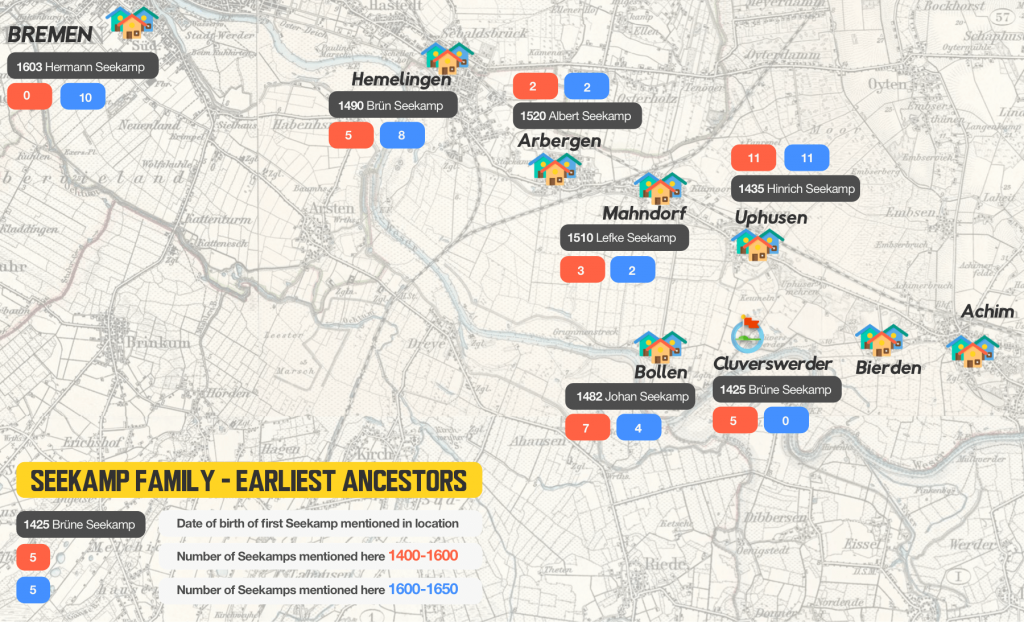
Footnotes
1. “Am 25.11.1481[1] „Der Amtmann des Stiftes Bremen, Heinrich Clüver, verkauft den Hebdomedarien (Mönchen?) am Dom für 100 Rhein. Fl. (Rheinische Gulden) Sekampswerder zu Bolme (Bollen) eine Rente von 6 Rhein. Fl., mit Vorbehalt des Wiederkaufes“. Stader Jahrbuch 1980, Die Familie Clüver, S. 77. StA Stade - Verlust. Leider ist diese Urkunde höchstwahrscheinlich 1943 in Hannover verbrannt.
2. Heinrich Clüver war zu der Zeit Amtmann des Stiftes Bremen. Source: StA Bremen Hann. Arch. Nr. 2583
3. Kurz darauf verpfändet er den ganzen Hof Seekampswerder an den Dom zu Bremen, wobei sein Sohn Gise Clüver mitwirkt. Der Hof ist verhäuert an Hinrich Seekamp und dessen Bruder. Source: HStA Hannover, Hann.Des. 27b.
4. Seekamp, Hermann 3 Herman! Namhaft im Akzisebuch mit Ankauf eines Postens Mehl, als er dafür die zugehörige Gebühr nach Seite 18 steuerte. SA 1570, 126. Im Jahr 1603 wurde ein erheblich jüngerer Träger seines Namens als Bürger aufge-nommen, siehe die Kladde Seite 143. Eine weitere Einbürgerung eines Gleichnamigen findet sich im Jahr 1616, siehe Kladde Seite 287.- [Die Maus, Bremer Einwohner vor 1650 >]
5. Meeting at the house of Johan Seekamp, Uphusen, 1646. Original text in German, transcribed by Ulrich Budler. Das Adliche Gut Clüverswerder, p 30-32. "Anno 1646, den 17.July, Ist eine beysahmenkunft der interessirten Guttsherrn an den Dorfschaften Uphause, Bührden undt Bollen, wegen streittigkeit der befriedigung, an Selbiger Vertmarcken, wieder den Haubtman Niclaß Cnausten zum Clüverß Wehrder p daselbst zu Uphause, angestellet undt gehalten p undt seint alda erschienen auf Johann Sehecamps Hofe, auß dem Bremischen Thum Capitull, Herr Johann Schade Probst, undt Ich Andresaß von Mandelslo: der Herr Gogreve des Gerichts Achim Otto Clüver p, Herr Eberhard Dotzen, J.U.D. un̄t Bürger M. der Stadt Bremen, der Ambt Schreiber zum Langwedel Samuell Wulfstiner. Sodann wegen des Closters Lyllienthael Hinricus Croiger, wie auch Herr Georg Hilmers Pastor zu Arbergen. Undt nach dem alda die Notturft dieser beisammenkunft zuvorderst beredet, haben sich selbige benandte anwesende Guthsherren an die Veltmarken nechst dem graben so umb den Wehrder geht, verfüget undt, daselbst hin, vorgemelten Nicolaißen Cnaust, von seinem Hofe zu sich erfordern laßen, welchem, nachdem er sich eingestellt, durch mich, in beywesen der guttherren auch der leuthe auß den benachbarten Dorfschaften folgende notturft undt meinung vorgehalten. Welcher gestalt, Kundbaren Herkommens, auch von undencklichen Jahren hero, es also observiret und practiciert, das die vorigen besitzeren selbigen Hofes undt gutts zum Clüvers od wie es von alters den nahmen gehabt, Sähekamps Wehrder p schuldig gewesen, auch noch, einen graben undt befriedigung umb denselben Wehrder uf Ihren alleinigen Unkostungen, also zuthalten, daß den benachbarten und umbliegenden Veltmarken von seinem Viehe dadurch keinen Schaden an Korn und sonst zugefüget würde, oder wütt solches gesche, die leuthe macht hatten, sein Viehe zu Schütten (beschlagnehmen) undt einzutreiben bis es wieder gelöset und der Schade erstatte. Hingegen aber man solche befriedigung dergestalt allenthalben nicht gemacht undt der benachbarten Viehe darüber geriehte, der besitzer solliches Wehrders alßdan keine fueg und macht hatte, dasselbe zu Pfänden od zu schütten p.
Wie solches alles dan, mit Johan Daelweg so viele jahre undt von Jugend auff bey den Clüvern undt Monnichhausen (Münchhausen) auff selbigen Wehrder gedienet undt dabey umbsorgen, sonsten ach selbsten vor sich denselbigen Wehrder undt dazu gehörige Landerey an die 9 Jahre lang verwalet, auch anderen alten leuthen undt protocollen darzuthun undt zu beweisen, auch von Selbigen Johann Dallwegh, Jetzo nochmals gegenwertig allß umbständlich eingezäunet worden, das nemblig in specie die Struckhauser so zu Bollen wohnen, die befriedigung von der Weser biß an den teich zu machen schuldig, die übrige befriedigung aber, alß von dannen biß auff die Döhlenwurth, von dannen um den Busch, hinter dem Baumhofe, biß auff den kleinen Schlabhaum undt umb die Kuhlen undt furters bey der Lake undt Wölktken Sehecamps Lande biß in die Weser, buten deichs, dem besitzer Selbigen Wehrders alleine zuzhalten obliegt und gebühre. Nuhn hätten aber die benannte benachbarte Dorfschaften sich öftermals gegen ihren Guthherrn zum höchsten beklagt und beschweret, das von Ihme Cnausten, solche befriedigung keines weges gemacht wurden, Sondern allenthalben, wie die Gutsherrn auch Jetzo im augenschein selbsten befunden, offen liegen undt von weidem Viehe in der leuthe Korn wie zu sehende, großer Schade dadurch verübet würde, undt wan dasselbe schon darüber einschütetten, er dasselbe etzliche Wochen stehen ließe, undt nicht wird löesen wollte. Dahero die leutte besorgeten, wenn er dasselbe verderben mochte, Sie es dennnoch dazu bezahlen mußte, undt als oftmals ohne entgelt wieder laufen laßen undt den Schaden vergebens haben müßten. Hingegen aber Herr Cnaust sich unterstunde wan der Dorfschaften Viehe durch seinen ungemachte graben undt befriedigung, geriethe dafür sie es gleichwoll zu hüten nicht schuldigk p daßelbe einzupfanden, biß es gelöset würde, gestalter auch, Herrman Bollmanns vier Schweine in solcher pfandung annoch bey sich hatte. Wan dan bey so beschafenem Zustandt, die guttherrn solches für unbillig erkenneten undt auch sothanen eingezogenen glaubwürdigen bericht auch aus jetzigem genommenen augenschein so viell befunden das er, Nicolaus Cnaust schuldig wirdt gehalten, gleich seinen antecessorn, die benannte befriedung also zu halten, das der benachbarten dadurch kein Schade wird fahre, auch von derselben Viehe dadurch nicht das Seine kehme, Er dasselbe zu pfanden mit nichten befuegt. So wollen Sie Ihme hiemit ernstlich ermahnet haben, zuvordest dem Bollman die eingeschüttete Schweine ohn entgelt als galt wieder loß zu geben, auch den leutten den zugefügten Korn Schaden, der billigckeit zu erstatten undt dan nachbarlich zu halten, das sich niemands darüber mit fuegen zu beschweren."6. 21-Jun-1546 "Vidimus des Rats über einen mit Albert Seekamp abgeschlossenen Contract, den die Beginen bei den schwarzen Mönchen mit ihrer halben Wurt zu Arbergen bemeiert haben." [Archiv Stade >] 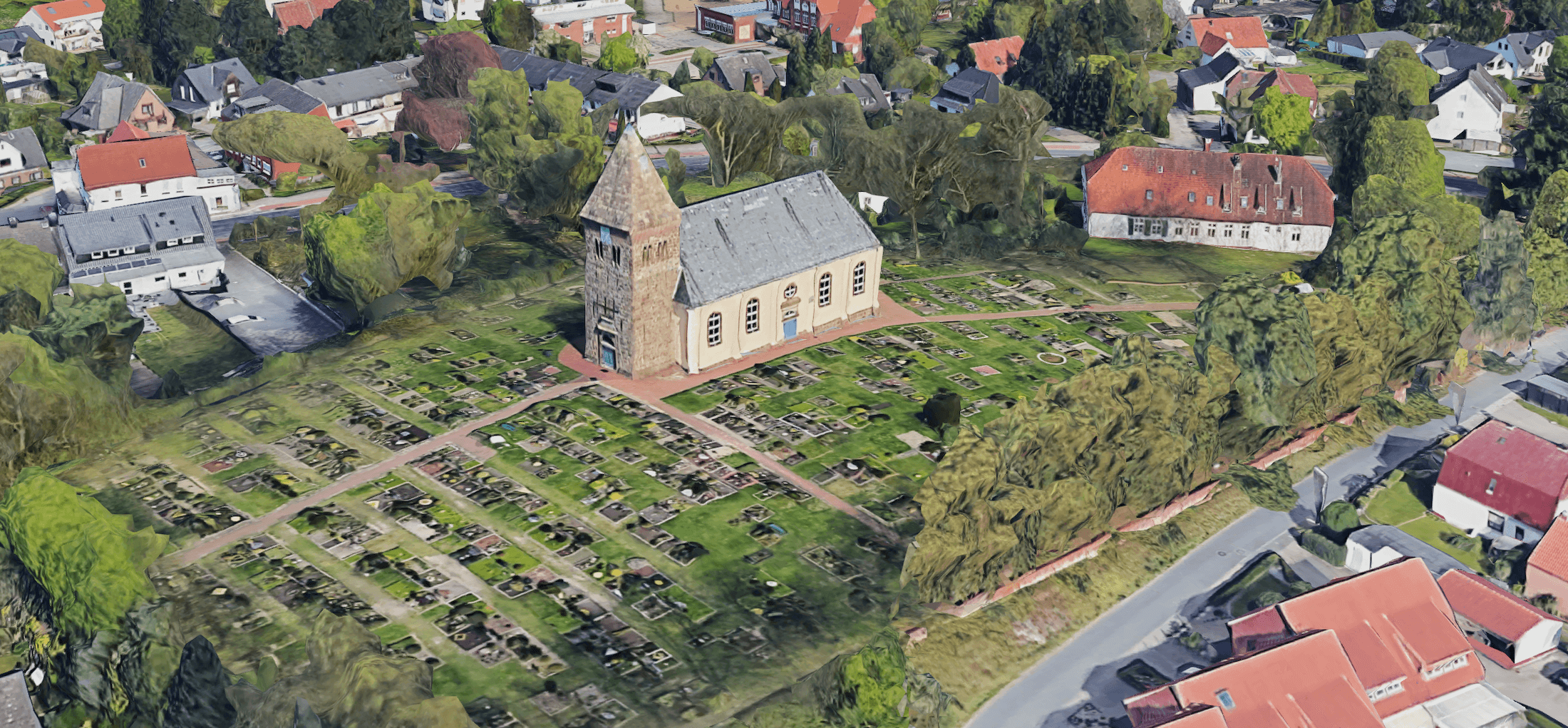




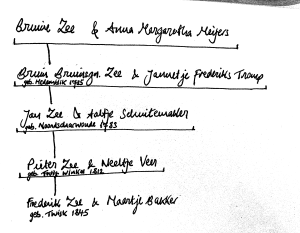




This is cool to know I figured it had to be German or something in that area but until today finding this information I had no clue how old my last name truly was
Hey Sarah! Yeah, 1481 – quite a long way back eh! There are some Seekamps in the US, and some in Australia … as far as I know all go back to the same origins near Bremen. Maybe you can start your family tree and find out!
My family history! Thank you for all this information….it bolsters the research I’ ve already done (on the famlienbuch site). I can’t wait to share this with my Seekamp family!
Hi John, that’s great! Glad to hear. Are you of the American or Australian branch of the Seekamps? I’m curious if you’ve managed to trace your ancestry back to Germany directly, and know when your Seekamp ancestor left for the ‘new world’? Cheers
Hi,
I’m from the American line…..my great grandfather Carsten Seekamp having come to New Nork City in 1862 from Scharmbeckstotel, a village near Bremen. He was a sailor on a wooden sailing ship on several voyages from Bremerhaven to England and then on to Bahia Brazil from 1858 to 1862. The schoonerbrig on which he sailed all but one of the 5 voyages he made was named the August Eberhard. The other was the Clarissa and then on the final voyage to New York he sailed on the ship Hermann. His father Hinrich was born in Hemelingen
In 1802 (listed as Seecamp) and I traced my direct lineage through him back to Johann Seecamp born in 1608 in Hemelingen. Hope you find this informing,
Cheers back!
Very cool John, great that you were able to get back so far! No doubt you’ve come across “Die Maus” (https://die-maus-bremen.info/) – lots of good info on the local families around Bremen. Thanks for sharing your story! Even if our link goes all the way back to 1481, we’re relatives! 🙂
Yes! Thanks to your hard work, I was able to fill my family tree. And yes I’ve visited die maus! A good site. I’m sure we’re related just based on the shared last name of Seekamp. Just a matter of how far back to go to find shared DNA
Regards,
John
My name is William Graham Seekamp. I am the son of Robert William Seekamp and Lorraine Graham Seekamp. My Grandfather William Seekamp came to the U.S.. around 1900. He married Martha Zimmerman Seekamp and they settled in Wallingford, CT and eventually moved to North Haven, CT. Mu Grandfather came from to town of Hemelingen, Germany. He was a silversmith and die cutter. He and Martha had two children, my father, and a daughter Carla.